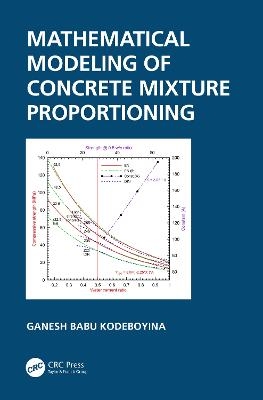
Mathematical Modeling of Concrete Mixture Proportioning
CRC Press (Verlag)
978-0-367-33480-2 (ISBN)
- Titel z.Zt. nicht lieferbar
- Versandkostenfrei innerhalb Deutschlands
- Auch auf Rechnung
- Verfügbarkeit in der Filiale vor Ort prüfen
- Artikel merken
The primary aim of this book is to put together an understanding of the appropriate principles of ensuring performance and sustainability of concrete. Broadly subdivided into three parts, first part contains the fundamental aspects introducing the constituent materials, the concepts of concrete mixture designs and the mathematical formulations of the various parameters involved in these designs. The second part is dedicated to discussing approaches and recommendations of American, British and European bodies related to mathematical modelling. Lastly, it discusses perceptions and prescriptions towards both the performance assessment and insurance of the resulting concrete compositions.
Ganesh Babu Kodeboyina has been a Professor of Structures and Materials in the Department of Ocean Engineering at the Indian Institute of Technology Madras for over 35 years. His passion for teaching and research in the areas of offshore and coastal structures; materials in marine environment; high performance cement and concrete composites; durability, corrosion and rehabilitation of structural systems; residual life assessment apart from fiber reinforced composites of both cementitious and polymeric nature including UHPCs endeared him to both students and industry professionals. Naturally, he was a retainer consultant to some of the largest cement industry giants as well as construction chemicals and repair materials manufacturers, both for evaluating the performance of the cements and composites produced by them and for their appropriate utilization in construction and repair and rehabilitation activity in field. He single-handedly put together and was the Head of an exceptionally comprehensive Structures, Materials, Applications and Rehabilitation Technologies (SMART) laboratory in the Department, which produced excellent research output through the very large crop of his several masters (both M.Tech and M.S by research) and doctoral students. He was also the Director of the Central Building Research Institute (CBRI), Roorkee, a constituent laboratory of the Council of Scientific and Industrial Research (CSIR) of Government of India for a few years. His emphasis on preservation of ancient monuments while being at the forefront of R&D of today, made sure that the one and only available double shell structure in the world, originally conceptualized, designed and built by none other than the first director of CBRI, Prof Kurt Billig, was completely refurbished from almost ruins to the present day display center of the CBRI. This facet of his passion also endeared him to the Archaeological Survey of India and others, seeking his advice and the assistance of his laboratory for several problems that are associated with the world Heritage structures like the Taj Mahal, the Sun Temples of Konark and Katarmal, Red Fort, just to name a few. Prior to his almost lifelong stint at IIT Madras, Prof. Ganesh Babu worked as a Scientist at the Structural Engineering Research Centre (SERC) of the Council of Scientific and Industrial Research of Government of India for about six years, immediately after his Ph.D. There he was coordinating research in several areas, like large diameter prestressed concrete pipes, concrete technology, fiber reinforced concrete, ferro-cement, and also established the polymer concrete laboratory through UNDP assistance. He was a consultant to the National Highway Authority of India for proof checking the several prestressed concrete bridge designs throughout the country, repair and rehabilitation of several large bridge structures, design and repair of important port and harbour facilities apart from being a committed teacher and a research worker. His research efforts resulted in the production of very high strength high performance concretes of about 120 MPa with almost all available pozzolanic admixtures like fly ash (from first field), silica fume, GGBS, metakaolin, RHA, and zeolite etc, in concrete. This was achieved through an assessment of the cementitious efficiency of the pozzolanic admixtures, in terms of their general efficiency and percentage efficiency factors defined by him, enabling the prediction of the strength of the concretes at the different pozzolanic replacement levels possible. His studies on the design and thermal cycling effects on heavyweight concretes for nuclear applications like prototype fast breeder reactor (PFBR), and the rehabilitation, residual life and life extension assessments for fast breeder test reactor (FBTR) at Kalpakkam are certainly noteworthy. His work on the corrosion of galvanized reinforcement as a part of the multinational research effort of the International Lead Zinc Research Organization (ILZRO) was highly acclaimed by the industry. Also, his contributions to high-strength high-performance concrete composites; performance, durability and corrosion of steel and concrete apart from fatigue and fracture mechanics of fibrous composites have been published in several national and international journals and conferences providing ample testimony to his understanding of the intricacies of these materials and structures, both on land and in the ocean space. He is presently an active consultant and is also a Professor at the Mahindra École Centrale, Hyderabad.
1. CONCRETE AND MODELLING CONCEPTS. 2. CONSTITUENT MATERIALS AND PROCESSING. 3. CONCEPTS OF CEMENTITIOUS MIXTURE DESIGN. 4. MODELLING AND UNIFICATION CONCEPTS. 5. AMERICAN RECOMMENDATIONS. APPENDIX PROG-ACI-NCNA-5. APPENDIX NCNA-5. APPENDIX NCA-5. APPENDIX NSNA-5. APPENDIX NSA-5. APPENDIX HSN-5. APPENDIX HSP-5. 6. THE BRITISH APPROACH. APPENDIX LAB-6. APPENDIX BSN-6. 7. EURO-INTERNATIONAL VISION. 8. PERCEPTIONS OF PERFORMANCE AND SUSTAINABILITY. 9. VERY HIGH PERFORMANCE AND SUSTAINABLE COMPOSITIONS. 10. PERFORMANCE REGULATORY EFFORTS. 11. FUTURE PROSPECTS AND POTENTIALS.
| Erscheinungsdatum | 03.03.2020 |
|---|---|
| Zusatzinfo | 21 Tables, black and white; 123 Illustrations, black and white |
| Verlagsort | London |
| Sprache | englisch |
| Maße | 156 x 234 mm |
| Gewicht | 740 g |
| Themenwelt | Mathematik / Informatik ► Mathematik ► Angewandte Mathematik |
| Technik ► Bauwesen | |
| ISBN-10 | 0-367-33480-1 / 0367334801 |
| ISBN-13 | 978-0-367-33480-2 / 9780367334802 |
| Zustand | Neuware |
| Informationen gemäß Produktsicherheitsverordnung (GPSR) | |
| Haben Sie eine Frage zum Produkt? |
aus dem Bereich


